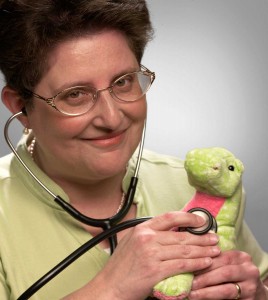Nov 13
2013
EHR Experiences: Dr. Lucy Hornstein, Valley Forge Family Practice

Dr. Lucy Hornstein, solo practitioner at Valley Forge Family Practice in Phoenixville, Penn., was not a proponent of electronic health records. An active physician blogger and published writer, she spent quite a few of her words on the technology’s uselessness.
They were expensive, overly complicated and tough to use and provided little return on the investment for users. Besides, most physicians, in her opinion, only implemented them because of meaningful use and the federal incentives they received for using them.
Paper, she had long decided, was good enough for her and during the first 21 years of practice in her own practice, she had no plans to change. It was only after the loss of one of her two staff members that she soon realized that she’d have to re-hire just to maintain her practice at its current load. However, that wasn’t an option for her. Neither, she thought, was adding an EHR to handle the management of the records because other than her perception of the technology, the self-described “dinosaur” didn’t have the budget for such an endeavor. She had zero for such technology.
Even if she had a change of heart and adopted the technology, she had not seen one system that was not cumbersome, not hard to use, intuitive to maneuver and or that offered her the option to meet the needs of her small practice while running the business efficiently.
Ultimately, though, she was introduced to the free (ad-supported) EHR by Practice Fusion, which “met her budget constraints” and she moved forward with as open a mind as possible and quickly settled in. Finally, after more than two decades of a paper-based practice (though there’s still paper in the practice, of course) she’s a full-fledged advocate of the technology.
Learning the system was easy, Hornstein said. “It was like playing a game; fun, easy and intuitive. It felt like I was playing a video game.”
Her favorite part of the technology is e-prescribing, being able to prescribe from anywhere. As far as meeting meaningful use Stage 1, the process was a breeze, she said – “A few point and clicks, go to CMS, point and click and done.” The actual attestation process took her less than an hour, and even though she runs a small practice, Hornstein said her system made the entire process quite simple. To this point, she figures it will be the same for Stage 2.
With the incentive money, about $16,000, she paid some bills and re-invested it in her practice. The money was a nice incentive for something that was fairly simple, but she still thinks “meaningful” use is meaningless because the things requested from a clinical standpoint rarely help her do her job as a physician. However, even though it’s a necessary evil, she said her EHR allows her to navigate the entire process seamlessly.
“Discovering Practice Fusion allowed me to do this, though, I’ve never been a technophobe, I am my own tech support and the computer is just a tool to help me practice medicine,” she said. “The other EHRs out there didn’t meet my need.”
Since implementing the system three years ago, she’s been able to move all of her patient files to the basement, cleared out her waiting room of file cabinets and now has access to a long-forgotten fire place and the stairs to the loft above her office. When she first made the change, patients came into the clinic, looked around and wondered if they were in the right place.
There interaction with the system has been smooth, as well, and very few have any concerns about their records being in electronic format. Hornstein doesn’t allow her record collection to get in the way of her relationship with her patients, either. In other words, she hasn’t let the EHR distract from her ability to care for patients even though she takes notes in the exam room while the patient is present. Almost all of her note taking is done in front of patients, she said.
If they want to see their record, she shows them. If they want her full attention, she puts it away. The patient portal also allows individuals easier access to their labs and results and they’re using it. It makes communicating a bit easier, she said.
“The technology helps me communicate when I need to further clarification,” she said of being able to quickly access up-to-date medical databases.
For her, records are always up-to-date and easily accessible, easy to use and the technology easily fits the budget of a small practice, she said. A few less worries for a doctor dedicated to documenting the ways in which practices such as hers are going the way of the dinosaur.
For now, that will have to wait: She’s got relationships with patients to nurture and a business to keep afloat. For now, her technology is helping do just that.